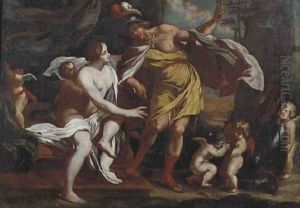Nicolaus Knupfer Paintings
Nicolaus Knupfer was a German Baroque painter who was born in Leipzig in 1603. He was an artist of significant skill and creativity, whose works contributed to the richness of Baroque art during the 17th century. Although not as widely recognized as some of his contemporaries, Knupfer played a pivotal role in the development of Dutch painting during his time, particularly in the city of Utrecht, where he spent a significant portion of his career.
Knupfer received his artistic training in Utrecht, a key city in the Dutch Republic that was a vibrant center for the arts. The exact details of his apprenticeship are not clear, but it is believed that he may have studied under Abraham Bloemaert, a prominent figure in the Utrecht school of painting. Knupfer’s work is characterized by its intricate detail, vivid color palette, and the expressive facial expressions of his figures. He specialized in small-scale biblical, mythological, and historical scenes, often imbued with a sense of narrative and emotional depth.
In Utrecht, Knupfer became part of a circle of artists that included notable painters such as Gerrit van Honthorst and Hendrick ter Brugghen, who were also instrumental in the introduction and development of Caravaggisti style in the Netherlands. While Knupfer's work shows some influence of the Caravaggisti, particularly in his use of chiaroscuro, his style remained distinctive, with a preference for intimate and finely detailed compositions.
Despite his contributions to the art world, Knupfer did not achieve the same level of fame or financial success as some of his peers. He worked for a discerning clientele, including members of the aristocracy and the intellectual elite, which allowed him some measure of creative freedom. However, records suggest that he lived modestly and that his work was not as widely commissioned as that of some other artists of his time.
Nicolaus Knupfer died in Utrecht in 1655. His legacy is preserved in a relatively small but significant body of work that reflects his mastery of composition, color, and narrative. Today, his paintings can be found in major museums and collections around the world, offering insight into the artistic landscape of the Dutch Golden Age and the diverse styles that characterized this period of art history.
